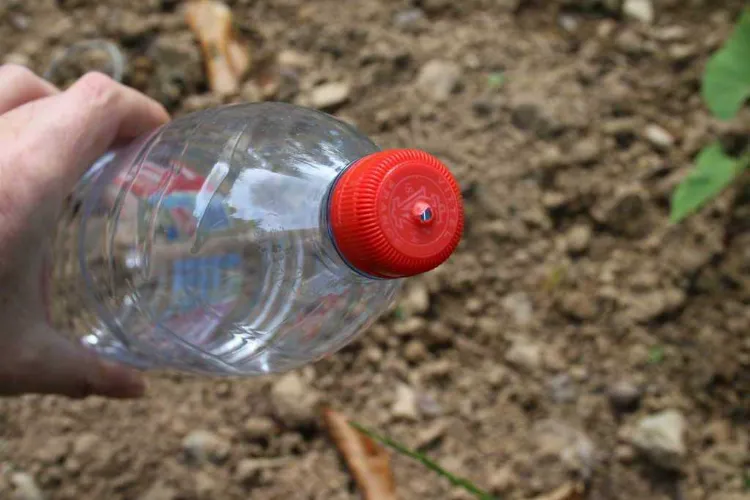With the approach of summer and the now traditional heat wave, drip irrigation is on everyone’s lips. Indeed, thanks to this watering system, you can considerably reduce your water consumption in the garden while making your life easier when you decide to go on vacation. How to make your own drip irrigation? We have what you need!
How to make your own drip irrigation?
Because water is a precious resource, it is important to reduce your consumption by adopting drip irrigation! Indeed, thanks to its position at ground level and its slowness, it proves to be more effective during the heat wave than sprinkling, which is much more direct. Thus, drip irrigation will ensure a constant supply of water to your plants, flowers or vegetable garden. How to make your own drip irrigation? Follow the leader!

How to make a drip with water bottles?
Watering your plants with a plastic bottle is an excellent solution, the simplest in fact. Here’s how:
- Bring a plastic bottle of 1.5
- Fill the bottle with water and screw on the cap
- Drill a hole in the cap
- Use the tip of a pair of scissors to slightly enlarge its diameter
- Flip the bottle
- Push its neck into the ground
- Make a hole in the bottom of the bottle
[Read: From Start to Harvest: A Beginner’s Guide to Organic Farming at Home]
This practical solution is equally valid for plants in pots and in the ground. However, for the latter, in case of wind, plant a stake next to the bottle and tie it with string to prevent it from overturning. We recommend that you install this system a few days in advance to test the flow time of the water and possibly drill the plug differently, to obtain a smaller or larger hole.
How do you water your plants when you go on vacation?
“Holidays, I forget everything, nothing more to do at all…” well no, you have to think about your plants and ensure their survival during your absence. Fortunately, there are simple home drip irrigation solutions available to everyone to make your life easier. First, regarding potted plants, simply move them to a place less exposed to the sun and wind: in the shade. Thus, your substrate will dry out less quickly and you will save a few waterings.
Also for indoor plants, the technique of soaked wool has long been proven. To do this, place a container of water above your plant. Then, connect a wool thread from the bottom of your container to the heart of the substrate of your plants. In this way, your plants will receive a regular supply of water by capillarity. Simple and efficient!
Finally, let’s finish with a very eco-friendly system with a natural, porous terracotta jar: the oyas. This ancestral watering system can be buried in the ground. Thus, the roots thus benefit from a regular supply of water thanks to the porosity of the pot. And this without making holes. It can be placed directly in the soil of the vegetable garden, in a vegetable bed or in a geotextile pot. In fact, this process would save up to 60% water compared to conventional watering.

How to make your own drip irrigation: what if you opted for a rainwater collector?
No need to draw you a picture: the collection of rainwater has many advantages that are gaining more and more followers. The rainwater collector allows, among other things:
- Conserve underground water reserves
- Save the energy needed to make it drinkable
- Limit stormwater runoff
- Feed the plants
- To save money
FAQ about drip irrigation systems
A: Drip irrigation systems are efficient and cost-effective, as they reduce water usage and minimize evaporation. They also deliver water directly to plant roots, ensuring that each plant receives the right amount of water.
A: Yes, you can use drip irrigation for all types of plants, including vegetables, fruits, flowers, and shrubs. However, some plants may require specific drip emitters or flow rates, so it’s important to do some research before installing a drip irrigation system.
A: The frequency of watering will depend on the type of plants you have, the weather, and the soil type. It’s important to monitor your plants regularly and adjust the watering schedule as needed.
In addition, by using recovered rainwater, we contribute to the good health of the planet by preserving underground water reserves which are diminishing at high speed. Several types of products exist according to your needs and constraints. The capacity of the tank varies according to the models chosen. The rainwater tank is the most basic model that is suitable for most households. Rainwater is collected in the hermetically sealed tank, which is installed near the downspouts. Depending on your needs, you are free to install an outlet tap or a water dispenser to allow access to rainwater. Not bad isn’t it?
By following these simple steps, you can easily make your own drip irrigation system. Drip irrigation is an efficient way to water your plants and can save you time and water in the long run. With a little planning and some basic materials, you can create a custom system that will keep your plants healthy and happy.





